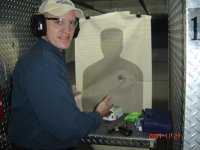If you're shooting with both hands from the hind legs (as O'Connor would say)- try flexing your kees just a tad, feet shoulder width apart, and place your strong-side foot about half to three quarters of your shoe length behind your off-side foot. Don't lock your elbows- just give them a tad of flex. Bring your pistol up to your line of sight- don't duck your grape down to the pistol. Stand up straight, don't let yourself lean backwards. As time goes by and muscle memory comes along, you can develop more of a crouch and lean forwards just a bit- but get the basics down first.
I used to preach whole-heartedly to shoot with both eyes open and learn to focus with the strong-side eye. But, age has caught up with me a bit and I find that when I shoot indoors under less than ideal lighting- I have to close my off-side eye to reduce the number of sights that mysteriously appear on the back-end of my pistol. So, if you're young- try to learn to do it with both eyes open.
I don't know what pistol(s) you're shooting or what their characteristics are, but read up on at least 10 different opinions of what trigger control means. Too slow of a pull on a heavy trigger is as bad in my opinion as too fast- find the sweet spot speed. Once the shot is fired, DO NOT release the trigger until you are back on target. For some odd reason- that will prevent you from (or break the habit of) "slapping" the trigger and helps with various other evils such as limp-wristing. Why? I've never figgered that out- I just know it helps a lot.
If you're shooting 9mm or bigger, try to keep your arms locked in that slightly bent shape as the shot is fired and try to roll with the recoil at your waist. You should see your front sight rise and you should be able to simply lean forwards back onto target. This will help you isolate any mistakes or loss of form from your shooting platform- it becomes especially helpful when you get up into the peppier .45's and such.
Another neat trick/drill you can work on, is without your firearm. Form your hand into what it looks like when you're holding the weapon for target presentation. Turn it slightly sideways so you can see all of your fingers, and place your index finger on an imaginary trigger. Now say the word "Sque-e-e-eze" Stretch the word out to about two seconds. As you say the word- move ONLY your trigger finger remembering to hold the imaginary trigger to the rear for another two seconds. Many new shooters will find that one or two other fingers move- the key is to isolate the trigger finger and only let it move. The reason to learn to isolate movement ONLY to the trigger finger is because any other movement will adversely effect the actuation of the shot even if ever so slightly. In one way or another- they will influence the grip/gripframe which is invariably almost always attached to the rest of the firearm (if not- see a professional Gunsmith ASAP!)
Sorry for going on so long- but I didn't see just a real clear addressment of your original questions. Will my pointers win you any matches? Probably not, but they are both sound in my opinion and have worked well for me as an instructor for just about 11 years now. They'll get you started and help you towards building your own shooting platform from which you can continue to learn and improve upon. Stay safe, have fun, and remember to introduce another new shooter to the sport when you're ready!
 , but now that I will have my CCW I feel responsible for making sure my accuracy is up to snuff. Thanks in advance, these forums are a great resource.
, but now that I will have my CCW I feel responsible for making sure my accuracy is up to snuff. Thanks in advance, these forums are a great resource.
